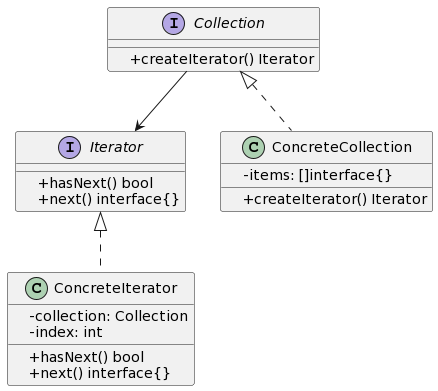1. What is the Iterator Pattern
The iterator pattern is a behavioral design pattern that provides a uniform method for traversing the elements of an aggregate object without exposing the internal representation of the aggregate object.
2. Characteristics and Advantages of the Iterator Pattern
The characteristics and advantages of the iterator pattern are as follows:
- It can hide the internal structure of the collection object, decoupling the traversal algorithm from the collection object.
- It provides a standardized way to traverse different types of collection objects.
- It simplifies client code, making it clearer and more concise.
- It can provide different implementations of iterators to adapt to different traversal needs.
3. Examples of Practical Applications of the Iterator Pattern
The iterator pattern has many practical applications, such as:
- Traversing a database query result set.
- Traversing files and folders in a file system.
- Traversing elements in a collection.
4. Implementation of the Iterator Pattern in Golang
4.1 UML Class Diagram

4.2 Example Introduction
In the UML class diagram above, we have two main roles: Iterator and Collection.
- The Iterator defines the interface for traversing a collection object, including the
HasNext()method to determine if there is another element and theNext()method to get the next element. - The ConcreteIterator is the specific implementation class of Iterator, implementing the
HasNext()andNext()methods. - The Collection defines the interface for creating iterator objects, with the
CreateIterator()method. - The ConcreteCollection is the specific implementation class of Collection, implementing the
CreateIterator()method.
4.3 Implementation Steps
Next, we will implement the Iterator pattern in Golang step by step.
4.3.1 Define the Iterator Interface and Concrete Iterator Class
type Iterator interface {
HasNext() bool
Next() interface{}
}
type ConcreteIterator struct {
collection *ConcreteCollection
index int
}
func (it *ConcreteIterator) HasNext() bool {
if it.index < len(it.collection.items) {
return true
}
return false
}
func (it *ConcreteIterator) Next() interface{} {
if it.HasNext() {
item := it.collection.items[it.index]
it.index++
return item
}
return nil
}
4.3.2 Define the Iterable Object Interface and Concrete Iterable Object Class
type Collection interface {
CreateIterator() Iterator
}
type ConcreteCollection struct {
items []interface{}
}
func (c *ConcreteCollection) CreateIterator() Iterator {
return &ConcreteIterator{
collection: c,
index: 0,
}
}
4.3.3 Implementing Iterator Generation Logic in Iterable Object Class
func main() {
collection := &ConcreteCollection{
items: []interface{}{"Golang", "Python", "Java"},
}
iterator := collection.CreateIterator()
for iterator.HasNext() {
item := iterator.Next()
fmt.Println(item)
}
}
Running the code above will produce the following output:
Golang
Python
Java
In the above code, we define a ConcreteCollection class that implements the Collection interface, with its CreateIterator() method returning an iterator object. We use this iterator object in the main() function for traversal.
4.4 Implementation Step Extension: Simplifying Iterator Implementation Using Generator Function
In Golang, we can simplify the implementation of iterators using a generator function (yield). Here is an example of using a generator function:
func GenerateItems() <-chan interface{} {
items := []interface{}{"Golang", "Python", "Java"}
out := make(chan interface{})
go func() {
defer close(out)
for _, item := range items {
out <- item
}
}()
return out
}
func main() {
for item := range GenerateItems() {
fmt.Println(item)
}
}
In the above code, we define a GenerateItems() function that returns a read-only channel (<-chan), and use yield to sequentially send elements to the channel within this function. In the main() function, we use range to traverse this read-only channel and output the element values.
This way, we have simplified the implementation of the iterator using a generator function.